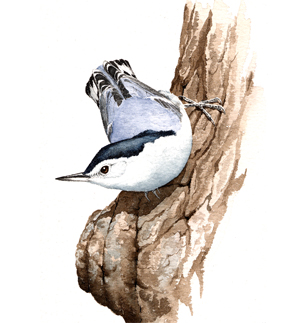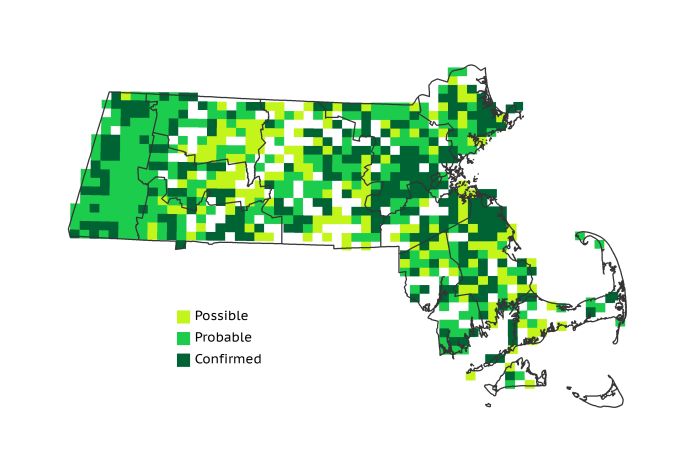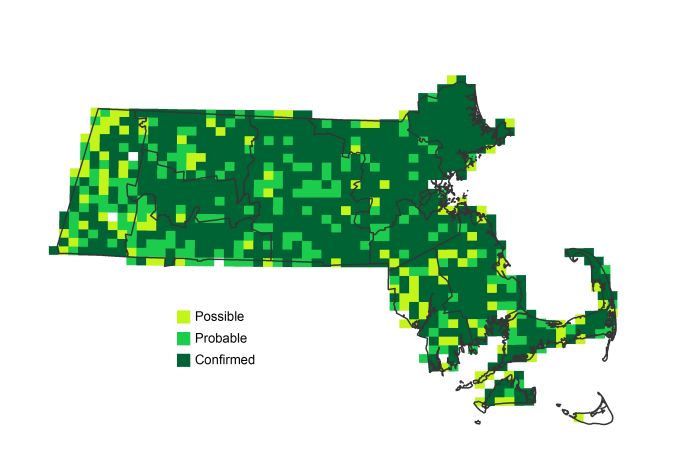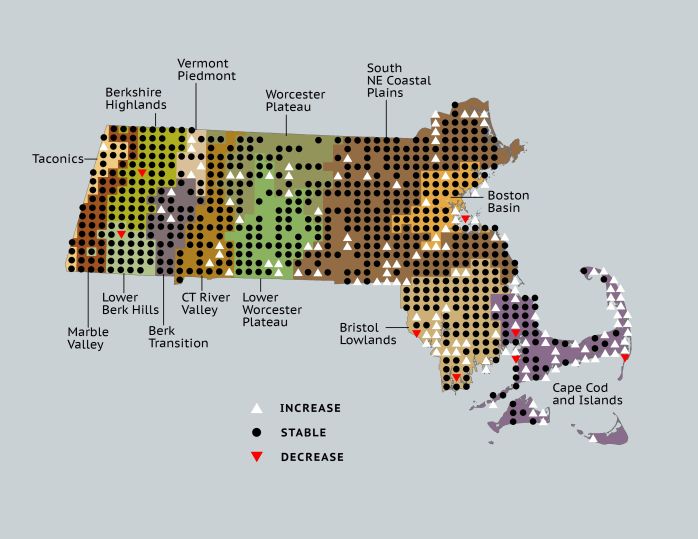Breeding Bird Atlases (BBA)
Find a Bird
White-breasted Nuthatch
Sitta carolinensis

Nearly ubiquitous and likely increasing
“Once or twice and maybe again, who knows, / the timid nuthatch will come to me / if I stand still, with something good to eat in my hand.” – Mary Oliver, “Winter and the Nuthatch”
A nasal yank, yank and a twitch of movement at the edge of vision are sometimes the only hints of the presence of a White-breasted Nuthatch. These expert climbers hitch quickly around the opposite side of a tree if they feel they are being watched, and they are just as quick to climb trees away from people as they are to descend headfirst towards them. Even so, White-breasted Nuthatches regularly overcome their shyness to visit a feeder during the colder months, especially those placed close to the edge of a wooded area.
Historic Status
Early chroniclers of the birdlife of Massachusetts knew the White-breasted Nuthatch well, but primarily as a migrant and winterer and less commonly as a breeder. In the first decade of the twentieth century Edward Howe Forbush wrote, “Most writers regard this common and familiar species as a bird of the forest; but in eastern Massachusetts it has become a frequenter of orchard and shade trees, and is commonly seen along village streets in fall, winter, spring, and sometimes even in midsummer, although comparatively few breed in the State” (Forbush 1907). In the early twentieth century, White-breasted Nuthatches declined in the southeastern corner of the United States, coinciding with an increase in breeding in Massachusetts.
Atlas 1 Distribution
Wherever mixed forest habitat was available during Atlas 1 – that is, nearly everywhere – White-breasted Nuthatches were found breeding. The Taconic Mountains, Marble Valleys, and Berkshire Hills boasted plenty of mature mixed forest, ergo, plenty of nuthatches. Despite a few pockets in the southern Connecticut River Valley and the Worcester Plateau regions where no breeding nuthatches were found, the species was generally widespread all the way to the Boston Basin. Only in the scrubby, conifer-dominated lowlands of the southeast did their distribution thin out significantly. The Cape and Islands had relatively few White-breasted Nuthatches with only 37% occupancy, and Nantucket had none.
Atlas 2 Distribution and Change
As Massachusetts’ forests matured between the two Atlas projects, the White-breasted Nuthatch adapted as well. Holding firm to its western Massachusetts roots, the species also pushed strongly into the eastern half of the state, colonizing sections of the Coastal Plains, the Boston Basin, the Bristol/Narragansett Lowlands, and the Cape Cod and Islands, which it had avoided during Atlas 1. The increase in the Cape and Islands was especially strong; when comparing the best-surveyed blocks, White-breasted Nuthatches expanded into 36% of the region from which they had previously been absent. The species was also more conspicuous in Atlas 2. Aside from being one of the most prevalent species (found in 962 blocks), it was also Confirmed attempting to breed twice as often in Atlas 2.
Atlas 1 Map

Atlas 2 Map

Atlas Change Map

Ecoregion Data
Atlas 1 | Atlas 2 | Change | ||||||
Ecoregion | # Blocks | % Blocks | % of Range | # Blocks | % Blocks | % of Range | Change in # Blocks | Change in % Blocks |
Taconic Mountains | 14 | 87.5 | 2.0 | 23 | 92.0 | 2.4 | 1 | 6.7 |
Marble Valleys/Housatonic Valley | 39 | 100.0 | 5.5 | 39 | 100.0 | 4.1 | 0 | 0.0 |
Berkshire Highlands | 54 | 98.2 | 7.6 | 54 | 98.2 | 5.6 | -1 | -1.9 |
Lower Berkshire Hills | 28 | 100.0 | 3.9 | 29 | 93.5 | 3.0 | -1 | -3.7 |
Vermont Piedmont | 9 | 52.9 | 1.3 | 17 | 100.0 | 1.8 | 4 | 33.3 |
Berkshire Transition | 33 | 86.8 | 4.7 | 40 | 100.0 | 4.2 | 3 | 9.7 |
Connecticut River Valley | 46 | 82.1 | 6.5 | 62 | 95.4 | 6.4 | 4 | 8.3 |
Worcester Plateau | 55 | 70.5 | 7.8 | 87 | 98.9 | 9.0 | 8 | 16.7 |
Lower Worcester Plateau | 55 | 74.3 | 7.8 | 80 | 100.0 | 8.3 | 5 | 9.3 |
S. New England Coastal Plains and Hills | 207 | 76.7 | 29.2 | 273 | 96.5 | 28.4 | 32 | 14.2 |
Boston Basin | 38 | 67.9 | 5.4 | 48 | 85.7 | 5.0 | 10 | 18.2 |
Bristol and Narragansett Lowlands | 81 | 76.4 | 11.4 | 105 | 92.1 | 10.9 | 18 | 17.8 |
Cape Cod and Islands | 50 | 36.8 | 7.1 | 105 | 72.9 | 10.9 | 43 | 35.8 |
Statewide Total | 709 | 73.2 | 100.0 | 962 | 92.8 | 100.0 | 126 | 15.2 |
Notes
The White-breasted Nuthatch shows significant increasing Breeding Bird Survey trends in Massachusetts, the New England/Mid-Atlantic Coast region, and the Eastern US overall.



